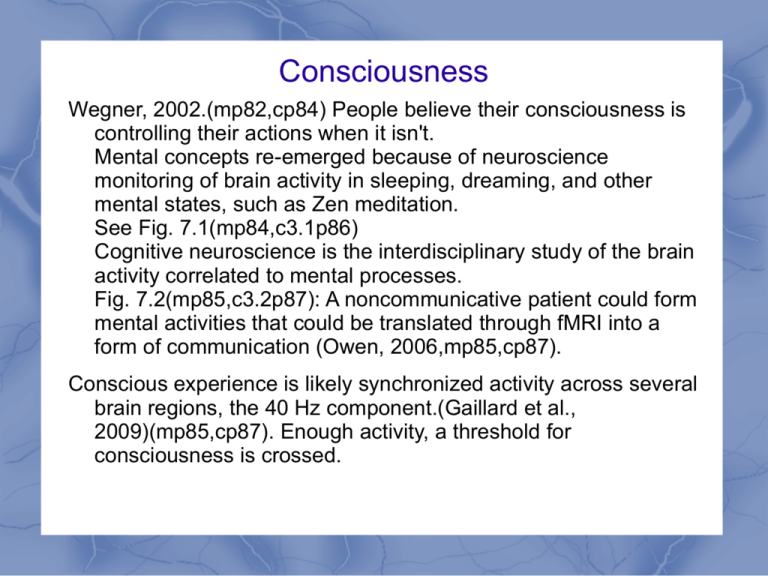Myers Module Seven
advertisement

Consciousness Wegner, 2002.(mp82,cp84) People believe their consciousness is controlling their actions when it isn't. Mental concepts re-emerged because of neuroscience monitoring of brain activity in sleeping, dreaming, and other mental states, such as Zen meditation. See Fig. 7.1(mp84,c3.1p86) Cognitive neuroscience is the interdisciplinary study of the brain activity correlated to mental processes. Fig. 7.2(mp85,c3.2p87): A noncommunicative patient could form mental activities that could be translated through fMRI into a form of communication (Owen, 2006,mp85,cp87). Conscious experience is likely synchronized activity across several brain regions, the 40 Hz component.(Gaillard et al., 2009)(mp85,cp87). Enough activity, a threshold for consciousness is crossed. Consciousness Blindsight is an example of parallel (dual?) processing. Subject cannot consciously see an object, yet can judge its weight and distance from their hands. Goodale and Milner hypothesize a visual perception track (neural pathways) separate from a visual action track. De Gelder 2010 (mp86.cp88): A subject who lost his left visual cortex, or blind to objects on the right side of his field of vison, can nevertheless sense the facial expressions of emotion.Can also be accomplished by trans-cranial magnetic stimulation. Libet, 2004: When you move your wrist at will, you consciously experience the decision to move about 0.2 seconds before the actual movement. For skilled athletes, action precedes awareness. Fig. 7.5(mp87,c3.5p89) Other researchers question the clock measurement procedure. Consciousness Selective attention: Your body processes 11 M bits/sec, of which you are only consciously aware of 40 bits/sec. You intuit the other bits. Cocktail party effect: Our neural networks can only consciously process one voice at a time. Smilek et al. 2010 mp88, cp90): When focused on a critical task, people will blink less. Multitasking comes at a cost: fMRI scans show that brain activity in areas vital to driving decreases an average 37% when the driver is attending to a conversation. (Just et al., 2008 mp88, cp90) Using a hands-free cellphone still increases accident risk by 4; talking to a passenger by 1.6 (McEvoy et al., 2007,mp89, cp90). Consciousness Inattentional blindness: . Focussing our attention on a select part of our environment causes us to miss important information about our environment. In the Mack & Rock, (2000,mp89,cp91) game viewers did not notice the young woman walking across the field with an umbrella. Change Blindness: Fig. 7.7(mp90, cp92) Choice Blindness: Fig. 7.8(mp90, cp92)People tasted two jams, indicated their preference, and then fooled by tricked jars, retasted their non-preferred jam without noticing.






